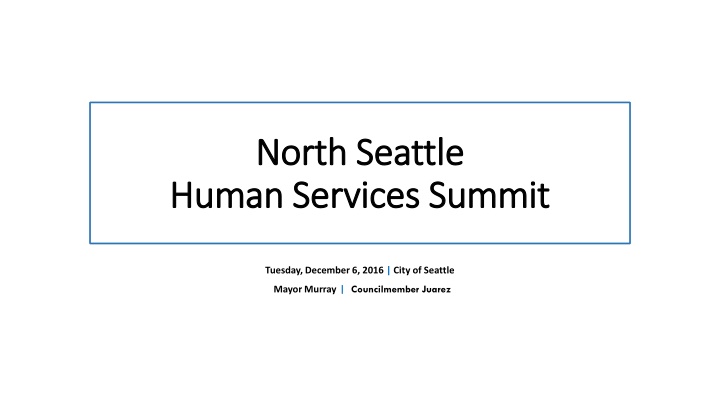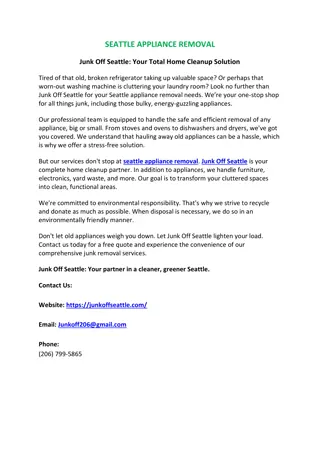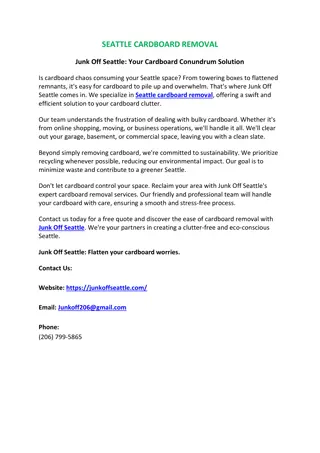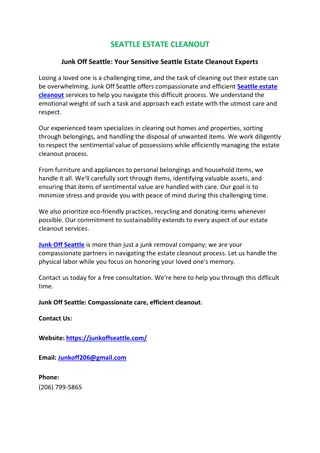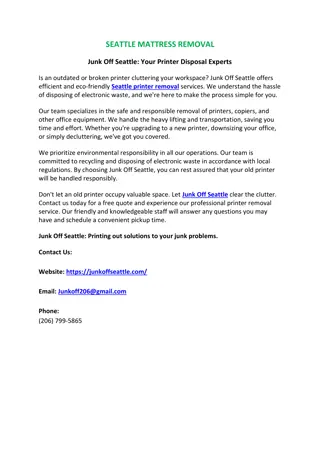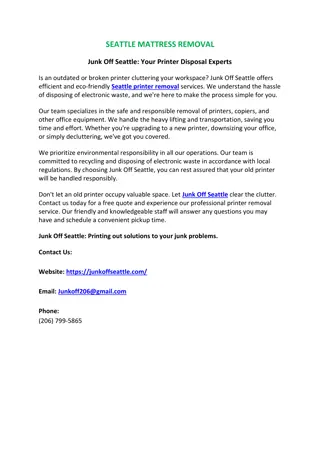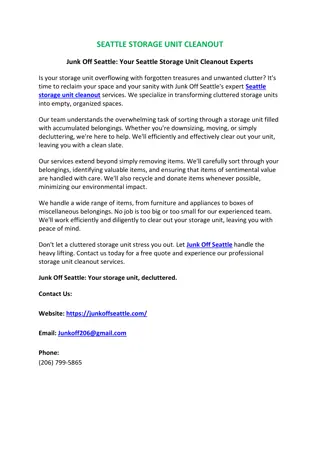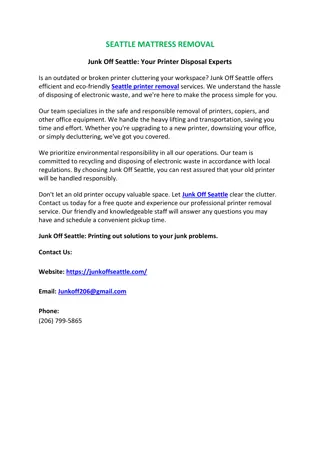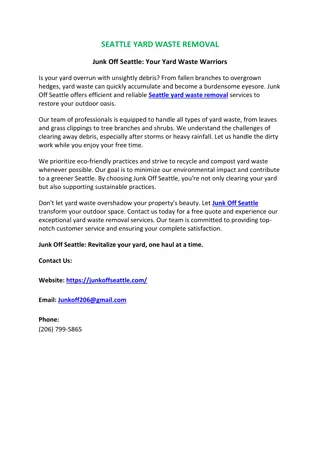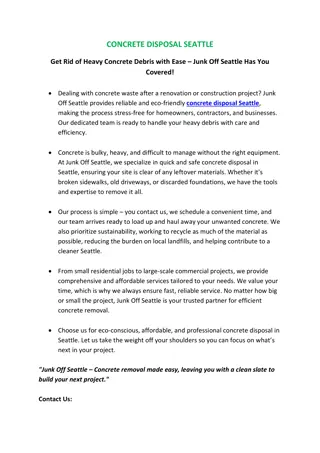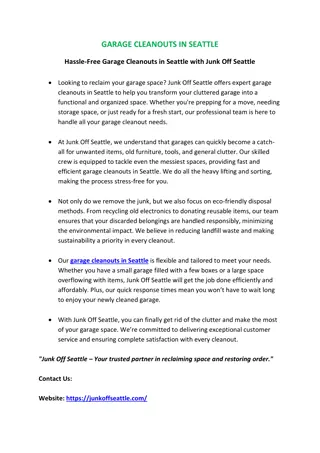Human Services Summit in North Seattle - Dec. 6, 2016
Analyzing data limitations, neighborhood poverty rates, and health reporting areas in North Seattle. Learn about key statistics and geographic definitions to understand community patterns.
Download Presentation

Please find below an Image/Link to download the presentation.
The content on the website is provided AS IS for your information and personal use only. It may not be sold, licensed, or shared on other websites without obtaining consent from the author.If you encounter any issues during the download, it is possible that the publisher has removed the file from their server.
You are allowed to download the files provided on this website for personal or commercial use, subject to the condition that they are used lawfully. All files are the property of their respective owners.
The content on the website is provided AS IS for your information and personal use only. It may not be sold, licensed, or shared on other websites without obtaining consent from the author.
E N D
Presentation Transcript
North Seattle North Seattle Human Services Summit Human Services Summit Tuesday, December 6, 2016 | City of Seattle Mayor Murray | Councilmember Juarez
Data Limitations Data Availability Data sets are published at various times. For this presentation, the most recent data available was analyzed and presented. Only data sets published on a regular basis were used for analysis; sources include US Census and the American Community Survey, Washington State Behavioral Risk Factor Surveillance System, Healthy Youth Survey, and Washington State Office of Financial Management. Sample Size Small sample sizes impact data analysis, particularly when trying to disaggregate race/ethnicity. To address this fact, multiple years of data were combined. Different Geographic Definitions Geographic areas are defined differently depending on the data source. For example, King County Public Health refers to specific areas as Health Reporting Areas (HRA) while the US Census uses Census Tracts. Self-Report Data Data collected through surveys rely on self-reported data. Surveys include: the US Census, Washington State Behavioral Risk Factor Surveillance System, and Healthy Youth Survey. Impact of University Students Because the North Seattle Region includes the University of Washington, data related to this area is not always comparable to the rest of the region, specifically data related to financial and race/ethnicity. 1
Neighborhoods in the northernmost part of Seattle Bitter Lake, Cedar Park, and areas around Northgate and Lake City experience high rates of poverty. However, consistently higher rates of poverty prevail in the southern part of Seattle. Data Shown by: Data Shown by: Census Tract Data Source: Data Source: US Census Bureau, 2010-2014 American Community Survey Notes: Notes: Poverty defined as at or below 100% of the Federal Poverty Level 2
Seattle is organized into 13 Health Reporting Areas (HRA) created by Public Heath to help examine patterns across Seattle and King County: Northwest 7% North 7% The North Seattle Region includes 5 HRA: Northwest, North, Ballard, Fremont/Greenlake, and Northeast. Ballard 8% Northeast 11% 41% of Seattle residents live in the North Seattle Region. Fremont/ Greenlake 8% North Seattle Region Health Reporting Area # % QA/ Magnolia 10% Northeast 69,162 11% Capitol Hill/E.lake 8% Ballard 54,214 8% Fremont/Greenlake 53,847 8% North 45,979 7% Downtown 8% Northwest 44,067 7% Central 7% QA/Magnolia 61,591 10% West 54,422 8% Capitol Hill/E.lake 48,537 8% Downtown 48,395 8% West 8% Central 46,312 7% Beacon/ Gtown/ S.Park 6% Southeast 43,050 7% Beacon/Gtown/S.Park 40,330 6% Southeast 7% Delridge 31,095 5% Delridge 5% Total 641,001 100% Data Shown by: Health Reporting Area (geographic definition used by Public Health) Data Source: Revised 2001 2009; 2011 - 2015: Washington State Office of Financial Management, Forecasting Division, single year intercensal estimates 2001-2009; 2011 - 2015. 3
Communities of color make up 35% of the Seattle population. Within this 35%, one-third live in the North Seattle Region. Asians, followed by Hispanic/Latinos, make up the largest communities of color in this region. Race/Ethnicity 10.00% 8.00% % of the Total Population of Seattle 7.68% 6.00% 2.22% 1.76% 7.53% 3.81% 4.56% 6.27% 6.72% 4.58% 0.05% 6.87% 0.08% 5.74% 0.32% 4.68% 0.37% 0.71% 4.00% 2.57% 0.56% 0.03% 0.43% 0.03% 1.08% 0.03% 0.31% 0.04% 0.62% 1.68% 0.06% 0.56% 0.03% 0.40% 0.54% 0.31% 0.02% 0.37% 0.51% 2.00% 0.03% 0.59% 0.66% 0.02% 0.03% 1.36% 0.82% 0.44% 0.02% 0.43% 0.24% 0.53% 0.35% 0.41% 0.52% 2.57% 0.40% 0.69% 0.36% 0.49% 0.44% 0.42% 0.16% 0.48% 1.85% 0.23% 0.41% 1.47% 0.32% 1.18% 0.22% 1.04% 1.03% 0.15% 0.83% 0.79% 0.88% 0.67% 0.06% 0.09% 0.06% 0.05% 0.57% 0.07% 0.06% 0.05% 0.08% 0.45% 0.10% 0.05% 0.13% 0.41% 0.07% 0.07% 0.00% Northeast North Northwest Fremont/ Greenlake Ballard Beacon/ Gtown/S.Park Southeast Central Downtown Delridge QA/Magnolia Capitol Hill/ E.lake West Health Reporting Area NorthSeattle Region Data Shown by: Health Reporting Area (geographic definition used by Public Health) Data Sources: Revised 2001 2009; 2011 - 2015: Washington State Office of Financial Management, Forecasting Division, single year intercensal estimates 2001-2009; 2011 - 2015. 4
In Seattle, the Northeast HRA contains the largest population as well as the largest population of residents between the ages of 15-24 (due to college-aged students attending the University of Washington). 0.5% Age 10.0% 0.6% < 5 15 to 24 65 to 74 5 to 9 25 to 44 75 and up 10 to 14 45 to 64 0.5% 0.7% 2.3% 0.4% 0.3% 0.6% 8.0% % of the Total Population of Seattle 0.4% 0.5% 0.7% 0.3% 0.5% 2.4% 0.5% 0.4% 0.5% 1.7% 0.5% 0.5% 0.5% 0.4% 0.5% 2.3% 0.5% 0.4% 0.5% 6.0% 2.9% 1.7% 2.6% 0.5% 1.9% 1.7% 1.9% 1.7% 1.8% 0.2% 1.6% 0.3% 3.6% 3.9% 4.0% 1.1% 3.5% 2.7% 3.6% 2.8% 2.5% 3.1% 2.0% 2.5% 3.4% 1.9% 1.7% 2.0% 1.6% 0.7% 1.2% 0.8% 1.1% 0.6% 0.6% 0.9% 0.8% 0.6% 0.4% 0.9% 0.4% 0.3% 0.3% 0.4% 0.3% 0.3% 0.3% 0.3% 0.5% 0.2% 0.2% 0.9% 0.4% 0.4% 0.4% 0.4% 0.3% 0.4% 0.3% 0.3% 0.2% 0.3% 0.3% 0.2% 0.5% 0.5% 0.5% 0.4% 0.4% 0.4% 0.4% 0.4% 0.4% 0.4% 0.4% 0.2% 0.0% Northeast Ballard Fremont/ Greenlake North Northwest QA/Magnolia West Seattle Capitol Hill/ E.lake Downtown Central Seattle Southeast Beacon/ Gtown/S.Park Delridge Health Reporting Areas NorthSeattle Region Data Shown by: Health Reporting Area (geographic definition used by Public Health) Data Sources: Revised 2001 2009; 2011 - 2015: Washington State Office of Financial Management, Forecasting Division, single year intercensal estimates 2001-2009; 2011 - 2015. 5
Neighborhoods in the northern most part of SeattleBitter Lake, Cedar Park, and areas around Northgate and Lake City have sizable Asian, Black/African American, and Hispanic/Latino populations. Percent of the Population Data Shown By: Census Tract Data Source: US Census Bureau, 2010 6
Neighborhoods in the northernmost part of Seattle Bitter Lake, Cedar Park, and areas around Northgate and Lake City have high concentrations of foreign-born populations. Percent of the Population that is Foreign Born >31% 20% <10% Data Shown By: Census Tract Data Source: American Community Survey, 5-year Series 2009-2013 7
Between January 2015 and September 2016, the City of Seattle Customer Service Bureau received: 169 service requests regarding discarded needles in the North Seattle Region. 1,633 service requests regarding homelessness in the North Seattle Region. Data Shown By: Seattle Neighborhoods Data Source: City of Seattle Customer Service Bureau 8
Between 2013 and 2015, the North Seattle Region accounted for nearly 13% of all deaths involving major drugs (opiates, cocaine, or methamphetamines) in King County. 11 1 * Approximate count for North Seattle 4 9 Data Source: King County Medical Examiner Records; Analyzed by UW Alcohol & Drug Abuse Institute
Within the North Seattle Region, older adults living in the Northwest HRA are less likely to report being in excellent, very good, or good health. They are also less likely to receive the social/emotional support they need. Compared to whites in the North Seattle Region, older adults of color report lower overall outcomes related to health and social/emotional support: Older Adults ( 60) Reporting Excellent, Very Good, or Good Health Older Adults ( 60) Receiving Social/Emotional Support they Need Older Adults ( 60) Reporting Excellent, Very Good, or Good Health Older Adults ( 60) Receiving Social/Emotional Support they Need North Seattle Region by Race/Ethnicity North Seattle Region by HRA White, non-Hispanic/ non-Latino 85% 84% Northwest 75% 73% North 80% 82% Non-whites* or Hispanic/Latino (Includes "other and "multiple races") Ballard 81% 87% 75% 72% Northeast 88% 83% Fremont/ Greenlake 91% 84% * All other race/ethnic groups other than white are grouped together because there are too few cases to adequately protect confidentiality and/or report reliable rates. Data Shown by: Health Reporting Area (geographic definition used by Public Health) Data Source: Health: Washington State Behavioral Risk Factor Surveillance System, 2005-2014 Social/Emotional Support: Washington State Behavioral Risk Factor Surveillance System, 2005-2012 Data Shown by: Health Reporting Area (geographic definition used by Public Health) Data Source: Health: Washington State Behavioral Risk Factor Surveillance System, 2005-2014 Social/Emotional Support: Washington State Behavioral Risk Factor Surveillance System, 2005-2012 10
North Seattle Region: Percent of people with an unmet healthcare need due to cost Within the North Seattle Region, people living in the Northwest HRA are more likely to go without healthcare treatment due to costs. North Despite the Affordable Care Act: Northwest 7% 19% 1 out of 9 white, non-Hispanic/ non-Latino residents in the North Seattle Region have an unmet healthcare need due to cost compared to Ballard 1 out of 14 non-whites* or Hispanic/Latinos (includes other and multiple races ). Northeast Fremont/ Greenlake 14% 6% 4% Too few cases to meet precision standards, interpret with caution * All other race/ethnic groups other than white are grouped together because there are too few cases to adequately protect confidentiality and/or report reliable rates. Data Shown by: Health Reporting Area (geographic definition used by Public Health) Data Source: Washington State Behavioral Risk Factor Surveillance System, 2014-2015 Note: Data was analyzed during the period when the health insurance marketplace was fully implemented through the ACA. 11
In the 2014-15 school year, North Seattle Region high school studentsof all racesgraduated at a higher rate than Seattle as a whole. However, racial disparities in North Seattle Region High Schools still exist: in general, white students graduated at higher rates than students of color. High Schools in the North Region of Seattle: Ballard, Ingraham, Nathan Hale, & Roosevelt All Seattle Public High Schools Graduation Rate Graduation Rate <82% Graduation Rate <82% Graduation Rate 83%* 83%* * U.S. Average graduation rate for 2014-15 school year was 83% Data Source: 2014-15State of Washington, Office of Superintendent of Public Instruction 12
Taking into consideration the racial breakdown of 8th, 10th, and 12th graders, North Seattle Region middle and high school students of color are less likely than white students to have an adult to talk to about something important. Black/African American Asian American Indian/Alaska Native Hispanic/Latino 63% 67% 63% 62% Native Hawaiian/Other Pacific Islander White 2 or More Races Other 84% 72% 76% 93% Data Source: Washington State Healthy Youth Survey, data available for even-numbered years: 2010, 2012, and 2014; 8th, 10th , and 12th graders surveyed with question about Having an Adult to Talk to About Something Important at 12 schools. Note: Only percentages are available for this data. 13
There are 28 elementary schools in the North Seattle Region. In the 2015-16 school year, 10 received state funding for full-day kindergarten: North Seattle Region: Percent of children starting school in 2015 who were kindergarten-ready across all six categories of the Washington Inventory of Developing Skills Children entering kindergarten in these schools were assessed on readiness using the Washington Inventory of Developing Skills across 6 categories: social/emotional, physical, language, cognitive, literacy, and mathematics. 4 of the schools performed below the Seattle Public School average of 52.3%. Seattle Public School Average: 52.3% Data Shown By: Seattle Neighborhoods Data Source: 2015-16State of Washington, Office of Superintendent of Public Instruction Note: Washington Inventory of Developing Skills is required only in state-funded full-day kindergartens. Absence of data for schools with enrolled kindergarten students may indicate that full-day kindergarten students in these schools are not state-funded. 14
In general, children who do not read proficiently by the end of 3rd grade are 4times more likely to drop out of high school. North Seattle Region: Percent of 3rd grade students in 2015-16 school year meeting grade-level reading standards 8 of the 28 elementary schools in the North Seattle Region performed below the Seattle Public School average of 65.7%. Seattle Public School Average: 65.7% Data Shown By: Seattle Neighborhoods Data Source: 2015-16State of Washington, Office of Superintendent of Public Instruction, The Annie E. Casey Early Warning! Why Reading by the End of Third Grade Matters 15
Overall, 37.8% of Seattle households or 1 out of 3 spend 30% or more of their income on housing regardless of whether they rent or own a home. North Seattle Region: Percent of cost-burdened households (who spend 30% or more of income on housing) and the percent of renters to homeowners by HRA Northwest Renters: 50.2% Homeowners:49.5% North Renters: 53.2% Homeowners:46.8% Likewise, 37.7% of households in the North Seattle Region are similarly cost-burdened. Northeast Renters: 43.8% Homeowners: 56.2% Ballard Renters: 45.8% Homeowners: 54.2% Fremont/ Greenlake Renters: 56.4% Homeowners:43.6% Data Shown By: Health Reporting Area (geographic definition used by Public Health) Data Sources: US Census Bureau, 2010-2014 American Community Survey. 16
At the time of the 2010 U.S. Census, Neighborhoods in the northernmost part of Seattle Bitter Lake, Cedar Park, and areas around Northgate and Lake City had high rates of unemployment. Current data for 2016, although not specific to the North Seattle Region, suggests unemployment is decreasing throughout Seattle as a whole. Legend >16% 12.8% - 16% 9.5% - 12.8 % 6.2 % 9.5 % 2.9% -6.2% <2.9% Data Shown by: Census Tract Data Source: US Census Bureau, 2010 17 Data Source: Washington State Employment Security Department
The North Seattle Region has several areas with limited food retail access. This is defined as an area where: Residents must travel more than mile to a food retailer (e.g. supermarkets, produce stands, and farmers markets) The median household income is below 80% of the citywide median of $60,665 North Seattle Region: Limited Food Retail Access Areas Additionally, some residents live near food retail areas but cannot afford to shop at them. This cost barrier leads them to seek more affordable food options farther away from home. 18 Data Source: US Census Bureau, 2006-2010 American Community Survey, Washington State Department of Social and Health Services, Public Health- Seattle & King County, King County GIS Center, and City of Seattle
North Seattle Region: Percent of people experiencing food hardship On average 10% of adults living in the North Seattle Region experience food insecurity. 16% non-whites* or Hispanic/Latinos (includes other and multiple races ) North Northwest 7% 16% compared to 8% ofwhite, non-Hispanic/non-Latino residents in the North Seattle Region Ballard indicated "sometimes" or "often" in the past 12 months their food did not last and they didn't have money to buy more. Northeast Fremont/ Greenlake 8% 5% 16% Too few cases to meet precision standards, interpret with caution * All other race/ethnic groups other than white are grouped together because there are too few cases to adequately protect confidentiality and/or report reliable rates. Data Shown by: Health Reporting Area (geographic definition used by Public Health) Data Source: Washington State Behavioral Risk Factor Surveillance System, 2007 and 2011-2013 Note: Data was analyzed during the period when the health insurance marketplace was fully implemented through the ACA. 19
6% of Seattle 8th, 10th , and 12th graders report being physically hurt on purpose by a dating partner in the past 12 months. In the North Seattle Region this number was 5%. Between January 2015 and September 2016, the Seattle Police Department filed 1,027 reports of domestic violence involving aggravated assault. 285 of those reports or 28% were filed in the North Seattle Region. 5% Yes 95% No Data Shown By: Micro-Community Policing Plans Data Source: Seattle Police Department Crime Dashboard, http://www.seattle.gov/seattle-police-department/crime-data/ crime-dashboard Data Sources: Washington State Healthy Youth Survey, data available for even-numbered years: 2010, 2012, and 2014; 8th, 10th , and 12th graders surveyed at 12 schools. 20
City of Seattle Funded Services Meals Data Shown By: Census Tract Data Sources: US Census Bureau, 2010-2014 American Community Survey 21
Community Assets 22 Data Shown By: Seattle Neighborhoods
Public Transportation Network Includes currently funded future transit 23 Data Source: City of Seattle, King County
